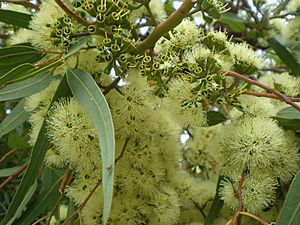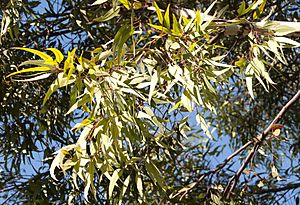Wandoo facts for kids
Quick facts for kids Wandoo |
|
|---|---|
 |
|
| Scientific classification | |
| Genus: |
Eucalyptus
|
| Species: |
wandoo
|
The Wandoo tree, also called dooto, warrnt, or wornt, is a special tree found only in the southwest part of Western Australia. It's a small to medium-sized tree with smooth bark. Its leaves are shaped like a spear, and its white flowers grow in groups. The fruit looks like a cone or cylinder. Wandoo is one of several similar trees in the Eucalyptus family.
Contents
About the Wandoo Tree
The Wandoo tree usually grows up to 25 meters (about 82 feet) tall. It has a special woody swelling at its base called a lignotuber. This helps the tree regrow if it gets damaged, like by a bushfire.
Bark and Leaves
The bark of the Wandoo tree is smooth and white. It often has patches of grey or light brown. Older bark peels off in flakes, and sometimes a few flakes stay on the trunk for a long time.
Young Wandoo plants and new shoots have stems that often look pale blue-green, like they're covered in a fine powder. Their leaves are egg-shaped or broad and spear-shaped. These young leaves are about 45 to 150 millimeters (1.8 to 5.9 inches) long and 25 to 75 millimeters (1 to 3 inches) wide.
Adult leaves are a greyish-green or greyish-blue color on both sides. They are shaped like a spear or are slightly curved. These leaves are about 75 to 125 millimeters (3 to 5 inches) long and 10 to 28 millimeters (0.4 to 1.1 inches) wide. They grow on a small stalk called a petiole, which is about 10 to 20 millimeters (0.4 to 0.8 inches) long.
Flowers and Fruit
The Wandoo's flower buds grow in groups of nine to seventeen. They are found where the leaves meet the stem. Each group of buds sits on a main stalk called a peduncle, which is about 8 to 20 millimeters (0.3 to 0.8 inches) long. Each individual bud has its own tiny stalk, about 3 to 5 millimeters (0.1 to 0.2 inches) long.
Mature buds are spindle-shaped and slightly curved. They are about 8 to 14 millimeters (0.3 to 0.6 inches) long and 2 to 4 millimeters (0.1 to 0.2 inches) wide. Each bud has a cone-shaped cap, called an operculum, which is often twice as long as the base of the flower.
Wandoo trees bloom from December or January to May, and their flowers are white. The fruit is a woody capsule (a type of seed pod). It is about 6 to 10 millimeters (0.2 to 0.4 inches) long and 5 to 6 millimeters (0.2 inches) wide. The parts that open to release the seeds are near the rim of the capsule.
How Wandoo Got Its Name
The Wandoo tree was first officially described in 1934 by a scientist named William Faris Blakely. He wrote about it in his book A Key to the Eucalypts. The name "wandoo" comes from the Noongar people, who are the traditional owners of the land where this tree grows. It's their name for the tree.
Wandoo Subspecies
In 1991, two scientists, Ian Brooker and Stephen Hopper, described two slightly different types, or "subspecies," of Wandoo. These are:
- Wandoo subsp. pulverea: This type has bark that looks powdery. Its small branches are often pale blue-green, and its young leaves are larger than the other type.
- Wandoo subsp. wandoo: This type does not have powdery bark. Its new bark is yellow, and its small branches are not pale blue-green. Its young leaves are narrower than those of subsp. pulverea.
Where Wandoo Grows
Wandoo trees grow across a wide area in Western Australia. You can find them from Geraldton in the north down to the south coast. They also grow inland as far as Narembeen. They prefer loamy (rich, fertile) and stony soils in hilly areas. The subsp. pulverea is less common and grows in a smaller area between Cataby and Morawa.
Wandoo's Conservation Status
Both types of Wandoo (E. wandoo subsp. pulverea and E. wandoo subsp. wandoo) are considered "not threatened" by the Government of Western Australia. This means they are not currently at risk of disappearing. However, scientists have studied how Wandoo forests are shrinking and how some trees are becoming unhealthy.
Uses of Wandoo Wood and More
The wood from the Wandoo tree is very strong and heavy. Because of this, it has been used for building things that need to be very durable. For example, it was used for railway sleepers (the wooden beams that support train tracks) and for strong wood flooring.
In the past, there was an industry that extracted tannin from the bark and wood of Wandoo trees. Tannin is a substance used in making leather and other products.
Today, Wandoo wood is not as widely available for cutting. This is because many Wandoo forests are now protected. They are preserved for people to enjoy for recreation, like hiking, and to help protect important water sources. Wandoo is also well-known for the delicious honey that bees make from its flowers.
Images for kids





